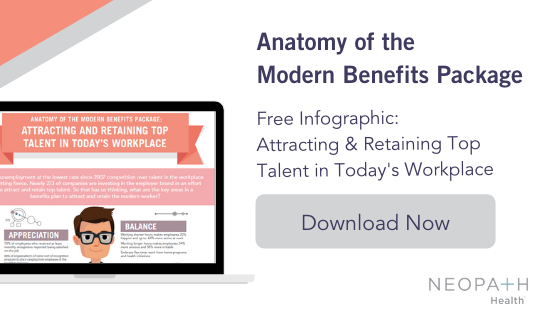As an HR professional it's part of the job description to understand people, their needs, and how to make and keep them happy. This attention is typically pointed toward your employee base, but when it comes time to convince your high-level Executives that your employee needs require company resources, you may need to focus some of your powers on painting a compelling picture for those professionals. Here are a few tips to putting together a great presentation that will help you convince them to fund your employees' new Benefits Program.
Presentation Tip #1: Know Your Audience
 As you are researching the different options for your employee Benefits Program, make sure to also do some research into the executives that will be involved in the decision-making process. First, be sure you know who will be involved and then work to understand what is important to each of those individuals. HR thought leader, Dr. John Sullivan recommends learning how to speak your executive’s strategic language to grab their attention. Research their position’s general responsibilities, find articles they've written or media they've been involved in to understand their perspective, or even include them in the research process by asking their priorities up front. Be sure to tailor your presentation to speak to the concerns and priorities of your decision-makers.
As you are researching the different options for your employee Benefits Program, make sure to also do some research into the executives that will be involved in the decision-making process. First, be sure you know who will be involved and then work to understand what is important to each of those individuals. HR thought leader, Dr. John Sullivan recommends learning how to speak your executive’s strategic language to grab their attention. Research their position’s general responsibilities, find articles they've written or media they've been involved in to understand their perspective, or even include them in the research process by asking their priorities up front. Be sure to tailor your presentation to speak to the concerns and priorities of your decision-makers.
Presentation Tip #2: Tell a Compelling Story
By the time you start putting together a presentation, you should fully understand the needs of your employees. You've probably completed surveys or done employee interviews or focus groups to gain their perspective. At this point, you should be able to explain the overall requirements of the group. However, according to personal advice gurus at SkillsYouNeed, you should also focus on telling a convincing story of a specific individual employee's struggle (anonymously of course) as a real-life example of why the new benefits program is absolutely necessary.
Presentation Tip #3: Reinforce Everything with Numbers
If there is one thing most C-level Executives agree upon, it is that they need to see and understand "the numbers" behind any decision. CEO's and CFO's care deeply about how any decision will affect the company's bottom line. Within your presentation, be sure to pay attention to cost, budget, and most importantly, Return On Investment (ROI). A good ROI is typically one of the most convincing arguments you can make at an executive level. Explain the ROI in detail, perhaps it will directly save the company money from the beginning because cost-savings are built-in. Maybe the excellent new benefit options will allow your company to retain and attract highly-talented employees, lowering the costs associated with recruiting or replacing employees that may leave the company. Be as specific as possible, boldly highlight any and all potential cost-saving opportunities.
Did you know Onsite Clinics can save your company money? Check out this post to learn more.
Presentation Tip #4: Timing is Everything
The first rule to any presentation is to keep it succinct. Most executives have extremely busy schedules with very little extra time, so make sure to come prepared and respect every minute you get with them. Include only the most relevant information in your presentation. A good practice here is to create the script in a bullet point list. Next, edit that list at least three times, each time removing any sentences or wording that doesn't directly support the primary points. The first round will be easy, but it will get harder each time especially from your own perspective as you've done so much work to gather all of the data, you may feel every single point is critical. Try to separate yourself and imagine you are an executive listening to the presentation, is there any information that seems less important from that perspective?
When presenting your benefits program to the executive team, keep it concise! Executives are busy so be prepared and include only relevant information! - Click to Tweet!
Presentation Tip #5: Create Your Presentation
After you have your script locked down, this is when you'll want to put together your slides or handouts for your presentation, not before. You've pared your script down to only the most important points, and now it is time to highlight those points very clearly in a visual way for your audience. Your visuals should be even more concise than the script itself. The thing to avoid here is including too much information or too many words. Ideally, you want your executives listening to the words you are saying, not reading a paragraph on a slide or getting lost in too many visual cues. Your visuals should be bold and minimal, numbers or statistics are great whenever possible.

Presentation Tip #6: Practice Your Pitch
The experts at Big Fish Presentations point out that timing is crucial in a presentation, and of course practice makes perfect. So, grab a stop watch and stand in front of a mirror to read through your script. Get to know how long it takes you to get through all of the information at a pace that is clear and easy to understand. Make sure that timing fits into the amount of time you have with your executives. You'll want to also be able to leave some additional time at the end of your presentation for Q & A, concerns, and clarifications. So, if you have 30 minutes scheduled with your execs, you may want to keep your presentation to 15 minutes or less.
Presentation Tip #7: Prepare for the Unforeseen
The end of the presentation, when things are opened up for discussion is typically the time when the best information is circulated. You will be able to better understand your executive’s concerns because they will be asking questions around them. Come prepared for some of the questions you think they may have, bring additional supporting stats or documentation. If there are questions you can’t answer in the moment, write them down and specify a timeframe within which you will provide the answers.
One of the most important things to remember as you head into your conversation with your executive team is that you are the professional they brought in to help guide them in their HR practices and policies. Go in with confidence, fully prepared, with an open mind and your employees’ best interests at heart, and your executive team will be funding your new program in no time.
.png?width=433&name=NeoPath_2019_logo_2color%20(1).png)




